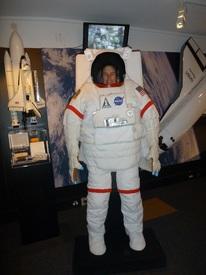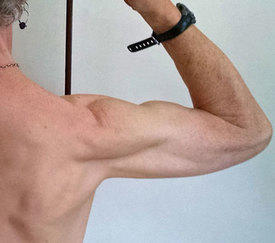Calories burned while lifting weights?

inherentst0rm
Posts: 84 Member
How many calories do you actually burn while doing things like Barbell Squats and Bench Press, as well as other weighted exercises?
0
Replies
-
There's an entry in the cardio section for weightlifting2
-
I used the one in the cardio section today for my Power Lifting class. Total calories burned for an hour equaled 172. I thought that was a bit low for my effort but I went with it.1
-
It's not a big calorie burner. Use the entry under the cardio section and be conservative with the amount you eat until you can get 4-6 weeks data, then adjust.
FWIW, I am a female, 5'2", and around 125 pounds and burn approximately 150 calories per hour following a power lifting program. This is based on 5 years of data from my results losing, bulking and maintaining.5 -
Difficult to determine...someone doing power lifting and taking longer rest periods is going to burn fewer calories than someone lifting with lighter weight and more reps and less rest is going to burn fewer calories than someone doing circuit training, etc.
1 -
This might be a stupid question (highly likely), but when people say that you burn less calories weight lifting than cardio, what is that based on? My heart rate gets to the same doing both - I wear a heart rate monitor, and I thought that the calorific burn would be mostly based on heart rate? Or is it actually based on type of motion?0
-
loveisapineapple wrote: »This might be a stupid question (highly likely), but when people say that you burn less calories weight lifting than cardio, what is that based on? My heart rate gets to the same doing both - I wear a heart rate monitor, and I thought that the calorific burn would be mostly based on heart rate? Or is it actually based on type of motion?
Heart rate is a terrible way of gauging calorie burn for lifting. It's only most accurate for steady state cardio. The calorie burns in the database are based on METS. https://en.wikipedia.org/wiki/Metabolic_equivalent3 -
Heart rate is a terribly way of gauging calorie burn for lifting. It's only most accurate for steady state cardio. The calorie burns in the database are based on METS. https://en.wikipedia.org/wiki/Metabolic_equivalent
My question is more around why that is? What is the actual mechanism that burns the calories?
I read the wiki on METS (thank you for that), and it basically states that a MET is a measure of exercise intensity, but what is defining intensity? I would have thought that would come back to heart rate, in which case my question remains as to why cardio burns more calories compared to weight lifting - if the heart rate is the same.
1 -
I too found the MFP burn accurate within a handful of cals to my own calculated burn form data.
I do 90 min at 200 cal. Long rests and 75% 1RM. 5'1 and maintaining at 103.
Cheers, h.
(I found I could eventually just up my cals by 1400 for the week with no gain)1 -
loveisapineapple wrote: »
Heart rate is a terribly way of gauging calorie burn for lifting. It's only most accurate for steady state cardio. The calorie burns in the database are based on METS. https://en.wikipedia.org/wiki/Metabolic_equivalent
My question is more around why that is? What is the actual mechanism that burns the calories?
I read the wiki on METS (thank you for that), and it basically states that a MET is a measure of exercise intensity, but what is defining intensity? I would have thought that would come back to heart rate, in which case my question remains as to why cardio burns more calories compared to weight lifting - if the heart rate is the same.
I only have a minute. I'm cooking and will make this short. I'm sure someone else will come along to elaborate.
Aerobic vs anaerobic activity.
In essence, heart rate does not determine calorie expenditure. Heart rate monitors count heart beats and then use an algorithm based on oxygen update during steady state cardio conditions. It then extrapolates calories from that.
During anaerobic activity, oxygen is used differently. The motions are usually intense and shorter in duration often with rest between. It's a different process in the body than aerobic activity and you usually end up burning fewer calories overall.
3 -
I would imagine the resting metabolism goes up with strength training. I don't even bother to calculate calories burned, I just know what I do and watch the scale and how I feel. Worn down, losing quick weight? Maybe add some calories. Not losing at all? Maybe drop the calories a bit.
The actual numbers would certainly be a combination of percentage of max lift and the rest period between.
Today I did a total of 200 reps, not including warm up sets, at about 70-75%... With a total of 18 mins "rest" (tho some 'rest' was spent loading/locating the bar). And the workout was worth more than the numbers.0 -
I use 120 cals/hr to log my lifting sessions, which based on my daily weight/cal records is accurate enough for me.
The 120 cals includes actual time lifting and rest time (3-5 mins) between sets but excludes rest/setup time (10-15 mins) between different lifts.1 -
Think of the heart being squeezed with outside pressure, and blood vessels compressed as well. Because of the pressure, thee amount of blood the heart can pump with each stroke is impaired. Therefore it has to pump faster to maintain flow. Heart is beating faster, but volume of blood being pumped is increasing only modestly. That’s strength training.
Now think of the heart being stretched out with a large volume of blood being pushed into it. It has to beat faster and harder to move that large volume of blood into blood vessels that are relatively relaxed. When heart beats faster, the volume of blood being pumped increases substantially. That’s cardio.
In both cases, heart rate increases. However, there are different things happening in the body during strength training vs during cardio.
Calorie burn depends on oxygen uptake, which is mostly determined by cardiac output (volume of blood pumped). So heart rate can be used to estimate oxygen uptake (and calorie burn) during ss cardio, but not during strength training. HRMs don’t know the difference.3 -
Weight lifting is an anaerobic exercise. You're actually burning more calories post workout. Your muscles don't get enough oxygen with high intensity workouts so it breaks down sugars for energy. Plus with more muscles, you boost your metabolism. I use to just run all the time, it was all about getting my cardio. But now I've incorporated weights and I get more results.3
-
beachgirl1130 wrote: »Weight lifting is an anaerobic exercise. You're actually burning more calories post workout. Your muscles don't get enough oxygen with high intensity workouts so it breaks down sugars for energy. Plus with more muscles, you boost your metabolism. I use to just run all the time, it was all about getting my cardio. But now I've incorporated weights and I get more results.
EPOC is pretty minimal numerically, too, and so is the "metabolic boost". Strength training is extremely worth doing, but calories aren't the reason..3 -
I think it has to do with volume lifted vs reps. Total volume is the great burner of calories If I remember correctly.0
-
I just use what MFP calculates. I don't eat back exercise calories because I set my own calorie goal based on a TDEE calculation that accounts for my workouts. I leave them in there because they numbers look pretty.1
This discussion has been closed.
Categories
- All Categories
- 1.4M Health, Wellness and Goals
- 398.2K Introduce Yourself
- 44.7K Getting Started
- 261K Health and Weight Loss
- 176.4K Food and Nutrition
- 47.7K Recipes
- 233K Fitness and Exercise
- 463 Sleep, Mindfulness and Overall Wellness
- 6.5K Goal: Maintaining Weight
- 8.7K Goal: Gaining Weight and Body Building
- 153.5K Motivation and Support
- 8.4K Challenges
- 1.4K Debate Club
- 96.5K Chit-Chat
- 2.6K Fun and Games
- 4.8K MyFitnessPal Information
- 13 News and Announcements
- 21 MyFitnessPal Academy
- 1.6K Feature Suggestions and Ideas
- 3.2K MyFitnessPal Tech Support Questions











